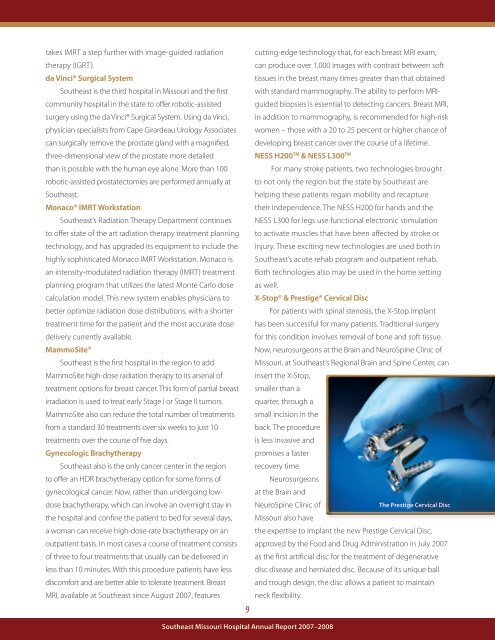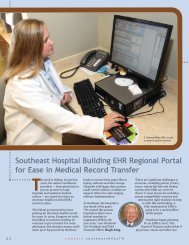Create successful ePaper yourself
Turn your PDF publications into a flip-book with our unique Google optimized e-Paper software.
takes IMRT a step further with image-guided radiation<br />
therapy (IGRT).<br />
da Vinci® Surgical System<br />
Southeast is the third hospital in Missouri and the first<br />
community hospital in the state to offer robotic-assisted<br />
surgery using the da Vinci® Surgical System. Using da Vinci,<br />
physician specialists from Cape Girardeau Urology Associates<br />
can surgically remove the prostate gland with a magnified,<br />
three-dimensional view of the prostate more detailed<br />
than is possible with the human eye alone. More than 100<br />
robotic-assisted prostatectomies are performed annually at<br />
Southeast.<br />
Monaco® IMRT Workstation<br />
Southeast’s Radiation Therapy Department continues<br />
to offer state of the art radiation therapy treatment planning<br />
technology, and has upgraded its equipment to include the<br />
highly sophisticated Monaco IMRT Workstation. Monaco is<br />
an intensity-modulated radiation therapy (IMRT) treatment<br />
planning program that utilizes the latest Monte Carlo dose<br />
calculation model. This new system enables physicians to<br />
better optimize radiation dose distributions, with a shorter<br />
treatment time for the patient and the most accurate dose<br />
delivery currently available.<br />
MammoSite®<br />
Southeast is the first hospital in the region to add<br />
MammoSite high-dose radiation therapy to its arsenal of<br />
treatment options for breast cancer. This form of partial breast<br />
irradiation is used to treat early Stage I or Stage II tumors.<br />
MammoSite also can reduce the total number of treatments<br />
from a standard 30 treatments over six weeks to just 10<br />
treatments over the course of five days.<br />
Gynecologic Brachytherapy<br />
Southeast also is the only cancer center in the region<br />
to offer an HDR brachytherapy option for some forms of<br />
gynecological cancer. Now, rather than undergoing lowdose<br />
brachytherapy, which can involve an overnight stay in<br />
the hospital and confine the patient to bed for several days,<br />
a woman can receive high-dose-rate brachytherapy on an<br />
outpatient basis. In most cases a course of treatment consists<br />
of three to four treatments that usually can be delivered in<br />
less than 10 minutes. With this procedure patients have less<br />
discomfort and are better able to tolerate treatment. Breast<br />
MRI, available at Southeast since August 2007, features<br />
9<br />
Southeast Missouri Hospital <strong>Annual</strong> <strong>Report</strong> <strong>2007–2008</strong><br />
cutting-edge technology that, for each breast MRI exam,<br />
can produce over 1,000 images with contrast between soft<br />
tissues in the breast many times greater than that obtained<br />
with standard mammography. The ability to perform MRIguided<br />
biopsies is essential to detecting cancers. Breast MRI,<br />
in addition to mammography, is recommended for high-risk<br />
women – those with a 20 to 25 percent or higher chance of<br />
developing breast cancer over the course of a lifetime.<br />
NESS H200TM & NESS L300TM For many stroke patients, two technologies brought<br />
to not only the region but the state by Southeast are<br />
helping these patients regain mobility and recapture<br />
their independence. The NESS H200 for hands and the<br />
NESS L300 for legs use functional electronic stimulation<br />
to activate muscles that have been affected by stroke or<br />
injury. These exciting new technologies are used both in<br />
Southeast’s acute rehab program and outpatient rehab.<br />
Both technologies also may be used in the home setting<br />
as well.<br />
X-Stop® & Prestige® Cervical Disc<br />
For patients with spinal stenosis, the X-Stop implant<br />
has been successful for many patients. Traditional surgery<br />
for this condition involves removal of bone and soft tissue.<br />
Now, neurosurgeons at the Brain and NeuroSpine Clinic of<br />
Missouri, at Southeast’s Regional Brain and Spine Center, can<br />
insert the X-Stop,<br />
smaller than a<br />
quarter, through a<br />
small incision in the<br />
back. The procedure<br />
is less invasive and<br />
promises a faster<br />
recovery time.<br />
Neurosurgeons<br />
at the Brain and<br />
NeuroSpine Clinic of<br />
The Prestige Cervical Disc<br />
Missouri also have<br />
the expertise to implant the new Prestige Cervical Disc,<br />
approved by the Food and Drug Administration in July 2007<br />
as the first artificial disc for the treatment of degenerative<br />
disc disease and herniated disc. Because of its unique ball<br />
and trough design, the disc allows a patient to maintain<br />
neck flexibility.















